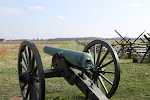Most people who know about Pearl Harbor, the battle that brought America fully into World War II, believe that the Japanese attack was completely without warning. The common misconception is that the first indication of attack occurred when Japanese bombs starting raining from the skies.
But before the planes of the Japanese arrived, their midget submarines were attempting to penetrate Pearl Harbor. One of these subs was spotted by a patrolling American warship.
On the morning of December 7, 1941, the U.S.S. Ward was conducting a precautionary patrol off the entrance to Pearl Harbor when crewmen spotted the submarine. The Japanese were attempting to sneak through the submarine nets into the harbor in the wake of another American vessel. A submarine inside the harbor could inflict horrendous damage, firing point blank into the moored battleships.
The Ward went into action, pummeling the sub with cannon shells and depth charges.
By the time the Ward's report of enemy contact reached the proper commanders, the skies over Oahu were dotted with Japanese bombers and fighters. Many doubted the Ward had really sunk a Japanese mini-sub until 2002 when scientists finally located its wreckage in 1,200 feet of water just outside Pearl Harbor. The conning tower is marked with two shell holes, exactly where the Ward's gunners said they struck it.
So it was not the Japanese who fired first but vigilant Americans guarding against enemy attack.
This is the after-action report filed by the U.S.S. Ward:
DD139/A16-3(7--)/
U.S.S. Ward Pearl Harbor, T.H.
December 13, 1941.
From: Commanding Officer.
To: The Commandant, Fourteenth Naval District.
(1) Commander Destroyer Division EIGHTY.
(2) Commander Inshore Patrol.
Subject:
Sinking of a Japanese Submarine by U.S.S. Ward.
1. While patrolling Pearl Harbor Entrance on Sunday, December 7, 1941, the U.S.S. Ward attacked an unidentified submarine in the Restricted Area off the Harbor.
The facts are as follows:
1. At 0637 the Officer-of-the-Deck said, "Captain come on the bridge." A conning tower with periscope of submarine was visible. She was apparently headed for Pearl Harbor trailing the U.S.S. Antares. The Antares was standing toward the channel entrance towing a lighter.
2. At 0640 the attack was started. The Ward bore down on the submarine while accelerating from 5 to 25 knots.
3. At 0645 the Ward opened fire with No. 1 and 3 guns and began dropping depth charges. One shot was fired from each gun. The shot from No. 1 gun missed, passing directly over the conning tower. The shot from No. 3 gun fired at a range of 560 yards or less struck the submarine at the waterline which was the junction of the hull and coning tower. Damage was seen by several members of the crew. This was a square positive hit. There was no evidence of ricochet. The submarine was seen to heel over to starboard. The projectile was not seen to explode outside the hull of the submarine. There was no splash of any size that might results from an explosion or ricochet.
4. Immediately after being hit the submarine appeared to slow and sink. She ran into our depth charge barrage and appeared to be directly over an exploding charge. The depth charges were set for 100 feet.
5. The submarine sank in 1200 feet of water and could not be located with supersonic detector. There was a large amount of oil on the surface where the depth charges exploded.
6. The attack was made at 0645 which was before Pearl Harbor was bombed by Japanese planes.
7. A dispatch by voice transmission was sent to Commandant, Fourteenth Naval District at 0645 which stated:
"We have attacked, fired upon, and dropped depth charges on a submarine operating in defensive sea areas."
8. The performance of duty by the officers and men during this attack was in accordance with the traditions of this service.
Pertinent Information
Appearance of submarine: Cylindrical tube about 80 feet long with small oval shaped conning tower. It had no deck. It was painted dark green and was covered with moss indicating that it had been at sea for a considerable period.
Behavior during attack: In spite of the five minute run from the time of sighting and time of attack, the submarine apparently did not see or detect the Ward. It was making from 8 to 10 knots and was apparently bent on following the Antares into port. Exact distances are not known but at the time of the first shot the range was not more than 100 yards and for the second shot the range was 50 yards or less. The submarine passed very close to our stern.
[signed]
W.W. OUTERBRIDGE
_______________________________________________________________
Source: Enclosure (E) to CINCPAC action report Serial 0479 of 15 February 1942, World War II action reports, the Modern Military Branch, National Archives and Records Administration, 8601 Adelphi Road, College Park, MD 20740.
_______________________________________________________________

















No comments:
Post a Comment